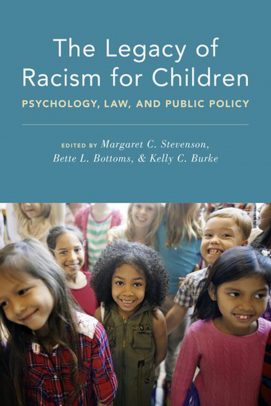Studies examine how race affects perceptions of law-involved Blacks, school discipline
The extent of discriminatory treatment Black adults and children experience at every point of contact within the legal system and the biases that result in Black children’s behavior being managed more harshly in school are detailed in two new analyses from researchers at the University of Illinois at Chicago.

Their findings are published in the forthcoming book “The Legacy of Racism for Children: Psychology, Law, and Public Policy.” The book explores the challenges that racial minority children face due to racism within U.S. law and public policy, from early life experiences to teenage years, and offers recommendations for informed policy and lawmaking. The book is co-edited by Bette L. Bottoms, UIC professor of psychology; Kelly Burke, UIC Ph.D. candidate in psychology; and Margaret Stevenson of the University of Evansville.
“Recent events have rightfully brought more attention to the ways in which Blacks face discrimination in our legal system,” Burke said. “Now more than ever is the time to learn from social science as we change the legal system to be equitable for all.”
Beginning with the first point of contact in the legal system – the police – racial disparities are evident in officers’ decisions to stop, arrest and use force, write the book’s co-editors and others in the chapter “Adults’ Perceptions of Law-Involved Minority Children and Youth: Implications for Researchers and Professionals.”
They report that prosecutors are more likely to seek the death penalty and defense attorneys are more likely to recommend plea deals resulting in more punitive outcomes for Black defendants in comparison to white defendants. Racial minority youth are more likely to be transferred from juvenile court into adult criminal court, making them less likely to receive rehabilitation-oriented services. At trial, judges and jurors are more likely to recommend harsher sentences and verdicts for Black defendants.
Burke notes that racial bias is not limited to offenders.
“When a victim is Black, versus white, police officers are less likely to make an arrest, prosecutors are less likely to seek the death penalty, and jurors are less punitive toward offenders,” she said.
The chapter’s authors, which also include Tayler Jones of UIC, Taylor Petty of University of Nebraska-Lincoln, and Gent Silberkleit of University of California-Davis, reviewed psychological research to understand why racial disparities exist, beginning with racial stereotypes.
Legal actors, such as police and jurors, are more likely to associate Blacks with crime and to perceive Black youth as older and more mature than white youth. They suggest that these stereotypes lead individuals to perceive Blacks, even children, as more threatening and culpable, resulting in harsher outcomes.
“Stereotypes that associate Black women and girls with promiscuity can explain why jurors are more likely to blame Black victims of sexual assault compared to white victims,” Burke said. “Beyond this, Blacks are disadvantaged by institutional and systemic racism, which contributes to inadequate access to proper legal defense.”
For Black children, experiences with school discipline are often not an opportunity to learn, they are a pathway into the criminal justice system, according to UIC’s Kate Zinsser.
The chapter she co-authored with Shannon B. Wanless of the University of Pittsburgh details implicit and explicit biases that result in Black children’s behavior being managed more harshly, perceived as more dangerous, and more often deemed sufficient to justify expulsion in comparison to their white peers.
“There are formal and informal pathways for removal, starting in preschool, and the consequences for Black children, in particular, are stark,” said Zinsser, UIC associate professor of psychology. “Policies often allow racial disproportionality in the school-to-prison pipeline to be ignored, or even facilitated.”
Zinsser and Wanless offer some ways that schools, districts, and teacher preparation programs can undo the school-to-prison pipeline, such as increasing educator knowledge and skills in a professional learning community, providing holistic supports to teachers, and enhancing preservice teacher preparation.
